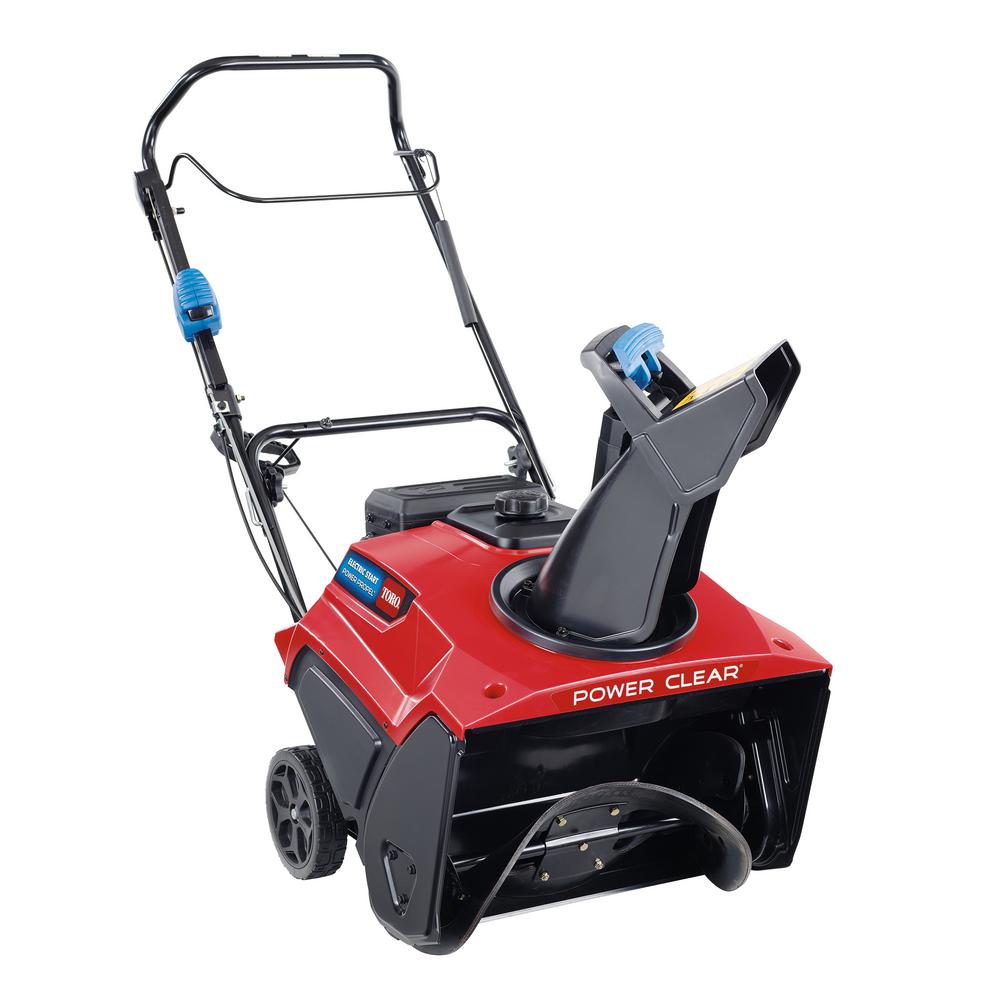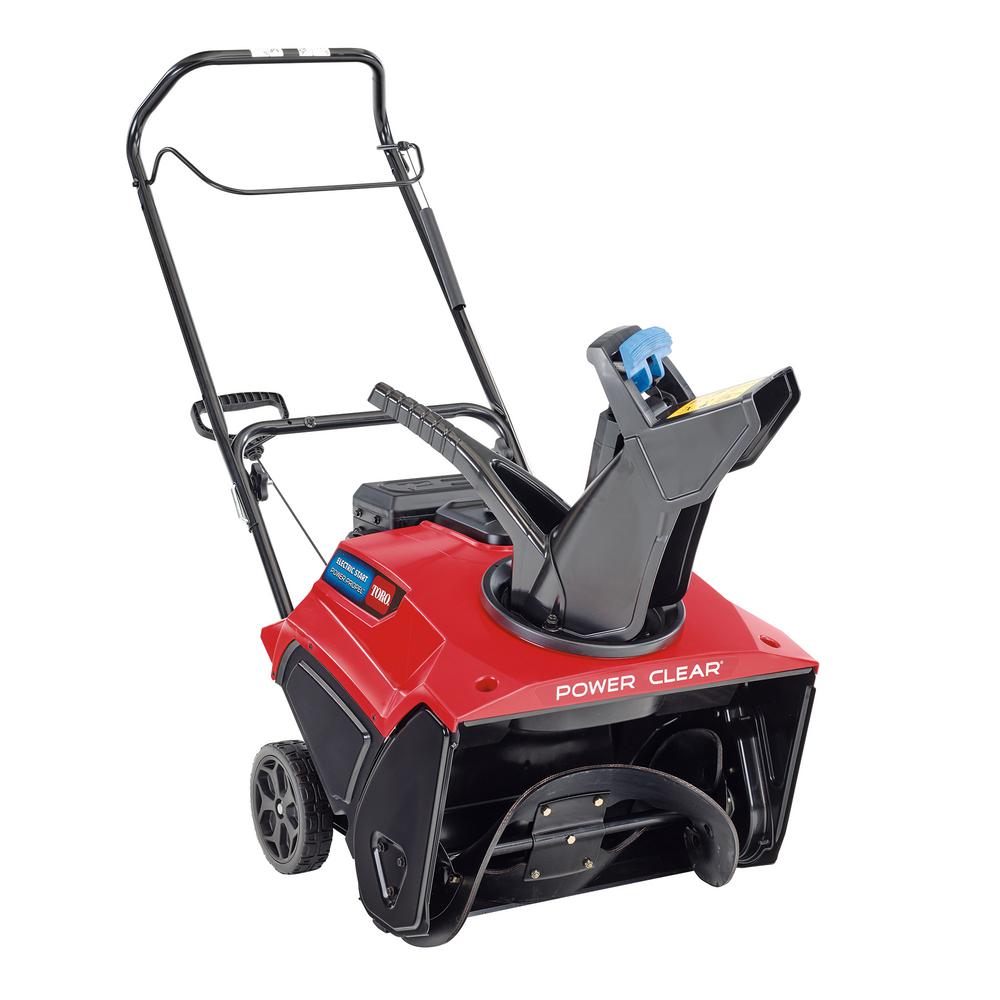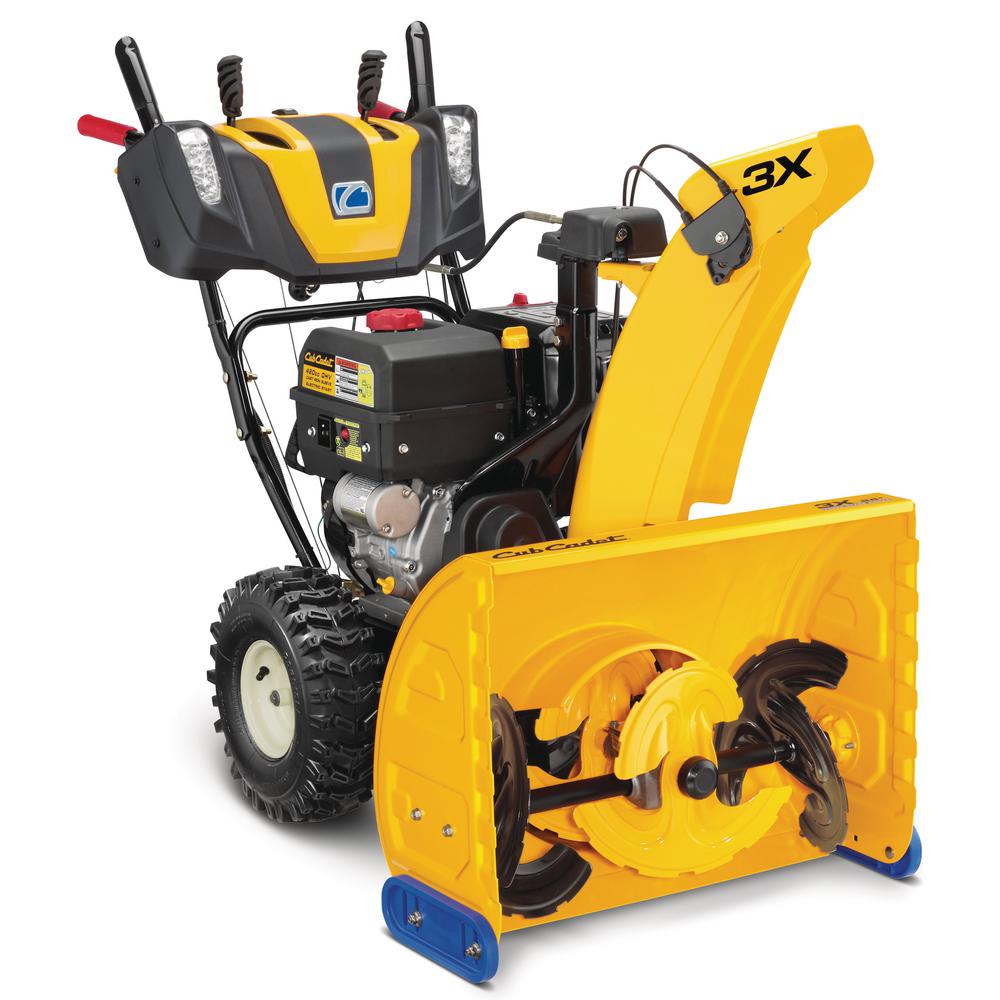Toro Power Clear 721 QZE 21 in. 212 cc Single-Stage Self Propelled Gas Snow Blower with Electric Start
Toro 21 inch Gas Self-Propelled Single Stage Snow Blower. Electric Start simple and easy to use with push button start. Chute Control, just squeeze and shoot.
The big game is nearly here but you’ve got snow to plow. No worries, you’ll be back to the action in no time with the Toro Power Clear 721 QZE Single Stage 21 in. Gas Snow Blower with Quick Chute. Quickly and easily change the chute direction without skipping a beat. Just squeeze the quick-shoot trigger and slide the grip. Starts easily with electric start. Even deep snow jobs are a cinch, as the 212cc 4-cycle OHV engine launches snow 35 ft. Shred snow fast with the patented Power Curve system, while the self propel Power Propel system gets you moving on quickly. You’ll have more room for storage with the blower’s compact design. With Toro’s 2-year Guaranteed-to-Start promise and warranty, you’re ready for whatever winter has in store. Count on it.
- Power to blast through snow; Toro’s powerful 212cc 4-cycle OHV engine give you the power to slice through snow in no time and throw it 35 ft.
- Easy start; simply push the button and you’re ready to snow blow with electric start
- Power to blast through snow; Toro’s powerful 212cc 4-cycle OHV engine gives you the power to slice through snow in no time and throw it 35 ft.
- Get a move on; keep moving to get the job done faster with the self-propel Power Propel system; the unique scraper keeps the paddle in constant contact with the ground, pulling you through the snow
- Shreds snow fast; efficiently shreds through snow while reducing clogging with the curved rubber paddles and housing of Power Curve Technology
- Put snow where you want it; with a touch of the hand, the locking deflector lets you aim exactly where you want to throw snow from the chute
- More Room for What Matters. The sleek, compact design means you can easily store it for quick use and have plenty of room for the stuff that really matters.
- Right fit for you; ideal for medium-sized driveways that can hold up to 9 parked cars, with limited garage or storage space
- We’ve got you covered; you can rest easy knowing Toro stands behind this product with a 2-year full warranty; count on it
- Guaranteed quick start; starts in 1 or 2 pulls with the guaranteed-to-start promise
- Tested and trusted; choose with confidence, knowing millions of people worldwide count on Toro snow blowers
- For best starting results use non-ethanol fuel with an octane rating of 87 or higher, use fresh fuel less than 30-days old, add fuel stabilizer to reduce starting problems, do not mix oil with gas
- Based on average Traqline unit share for snow blower market from 2013 – March 2020
Additional information
| Assembled Depth x Height x Width(in.) | 48 x 42 x 21 |
|---|---|
| Auger Diameter (in.) | 8.5 |
| Clearing Width (In.) | 21 |
| Ideal Snow Depth (In.) | 9 |
| Intake Height (in.) | 12.5 |
| Tire Height (in.) | 7 |
| Tire Width (in.) | 1.75 |
| Certifications and Listings | No Certifications or Listings |
| Manufacturer Warranty | 2-Year Full with Guaranteed to Start |
Twenty-one, XXI or 21 may refer to:
- 21 (number), the natural number following 20 and preceding 22
- The years 21 BC, AD 21, 1921, 2021
Year 212 (CCXII) was a leap year starting on Wednesday (link will display the full calendar) of the Julian calendar. At the time, it was known as the Year of the Consulship of Asper and Camilius (or, less frequently, year 965 Ab urbe condita). The denomination 212 for this year has been used since the early medieval period, when the Anno Domini calendar era became the prevalent method in Europe for naming years.
Year 721 (DCCXXI) was a common year starting on Wednesday (link will display the full calendar) of the Julian calendar. The denomination 721 for this year has been used since the early medieval period, when the Anno Domini calendar era became the prevalent method in Europe for naming years.
Clear may refer to:
- Transparency, the physical property of allowing light to pass through
Gas is one of the four fundamental states of matter. The others are solid, liquid, and plasma. A pure gas may be made up of individual atoms (e.g. a noble gas like neon), elemental molecules made from one type of atom (e.g. oxygen), or compound molecules made from a variety of atoms (e.g. carbon dioxide). A gas mixture, such as air, contains a variety of pure gases. What distinguishes gases from liquids and solids is the vast separation of the individual gas particles. This separation usually makes a colorless gas invisible to the human observer.
The gaseous state of matter occurs between the liquid and plasma states, the latter of which provides the upper-temperature boundary for gases. Bounding the lower end of the temperature scale lie degenerative quantum gases which are gaining increasing attention. High-density atomic gases super-cooled to very low temperatures are classified by their statistical behavior as either Bose gases or Fermi gases. For a comprehensive listing of these exotic states of matter, see list of states of matter.
In philosophy, the self is an individual's own being, knowledge, and values, and the relationship between these attributes.
The first-person perspective distinguishes selfhood from personal identity. Whereas "identity" is (literally) sameness and may involve categorization and labeling, selfhood implies a first-person perspective and suggests potential uniqueness. Conversely, "person" is used as a third-person reference. Personal identity can be impaired in late-stage Alzheimer's disease and in other neurodegenerative diseases. Finally, the self is distinguishable from "others". Including the distinction between sameness and otherness, the self versus other is a research topic in contemporary philosophy and contemporary phenomenology (see also psychological phenomenology), psychology, psychiatry, neurology, and neuroscience.
Although subjective experience is central to selfhood, the privacy of this experience is only one of many problems in the philosophy of self and scientific study of consciousness.
Snow comprises individual ice crystals that grow while suspended in the atmosphere—usually within clouds—and then fall, accumulating on the ground where they undergo further changes. It consists of frozen crystalline water throughout its life cycle, starting when, under suitable conditions, the ice crystals form in the atmosphere, increase to millimeter size, precipitate and accumulate on surfaces, then metamorphose in place, and ultimately melt, slide or sublimate away.
Snowstorms organize and develop by feeding on sources of atmospheric moisture and cold air. Snowflakes nucleate around particles in the atmosphere by attracting supercooled water droplets, which freeze in hexagonal-shaped crystals. Snowflakes take on a variety of shapes, basic among these are platelets, needles, columns and rime. As snow accumulates into a snowpack, it may blow into drifts. Over time, accumulated snow metamorphoses, by sintering, sublimation and freeze-thaw. Where the climate is cold enough for year-to-year accumulation, a glacier may form. Otherwise, snow typically melts seasonally, causing runoff into streams and rivers and recharging groundwater.
Major snow-prone areas include the polar regions, the northernmost half of the Northern Hemisphere and mountainous regions worldwide with sufficient moisture and cold temperatures. In the Southern Hemisphere, snow is confined primarily to mountainous areas, apart from Antarctica.
Snow affects such human activities as transportation: creating the need for keeping roadways, wings, and windows clear; agriculture: providing water to crops and safeguarding livestock; sports such as skiing, snowboarding, and snowmachine travel; and warfare. Snow affects ecosystems, as well, by providing an insulating layer during winter under which plants and animals are able to survive the cold.
Start can refer to multiple topics:
- Takeoff, the phase of flight where an aircraft transitions from moving along the ground to flying through the air
- Starting lineup in sports
- Standing start, and rolling start, in an auto race
With or WITH may refer to:
- With, a preposition in English
- Carl Johannes With (1877–1923), Danish doctor and arachnologist
- With (character), a character in D. N. Angel
- With (novel), a novel by Donald Harrington
- With (album), a 2014 album by TVXQ
- With (EP), a 2021 EP by Nam Woo-hyun






by Baller
Great snowblower. Works really in NJ snow. Even cleaned 2 feet of snow.
by Alvarado
Thank you for the good service to the tow jong ones and the tow ladys thank you I am very pleasent with your service !
by Mike
Starts every time on the first pull. I love the chute lever , it’s quick and easy to adjust.
by Bill
I love my new Toro. It’s very easy to operate, even one handed! It cleans right down to the pavement and throws the snow easily and as far as you may need. I’m 68 and my other blower just got too hard to handle and maneuver about…so I sold it!
by Thomas
Everything is great about this machine.
by Paul
The only regret I have is, that I should have purchased one with a transmission. Other than that this is a good product.
by Mark
4th snow blower but 1st Toro. I am thrilled. Third season now. Starts 1st pull every time, chute never clogs, change chute direction on the fly, cleans down to the pavement, throws far enough for my 3 car garage driveway. Buy this!!